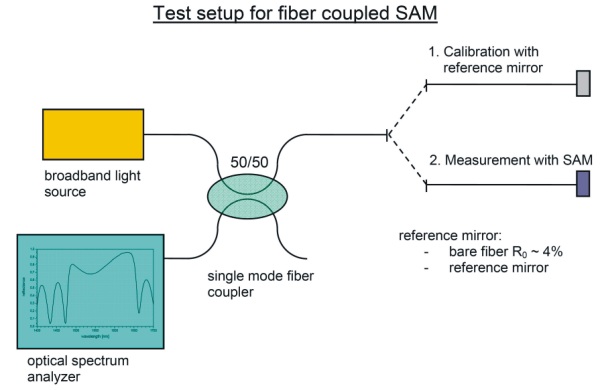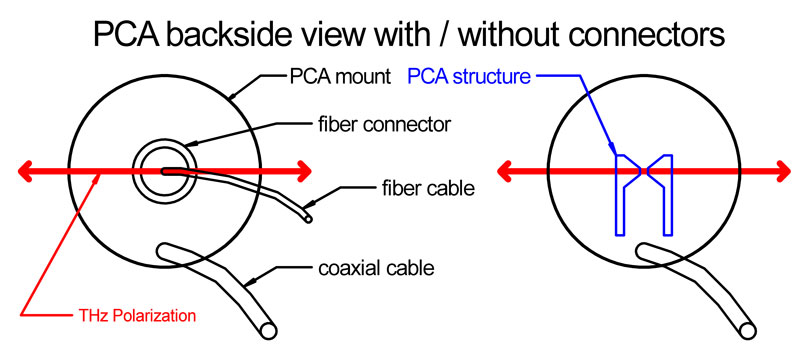> Energy band gap>
GaAs |
AlxGa1-xAs |
InxGa1-xAs
> Refractive index
> GaAs |
AlAs |
AlxGa1-xAs |
InxGa1-xAs
> Devices
> Bragg mirror |
SAM |
RSAM |
SA |
SANOS |
SOC |
Microchip |
PCA
> Device application
> Papers|
Patents |
FAQs

FAQs - frequently asked questions and answers
Questions about saturable absorber mirror (SAM)
Can I clean a dirty SAM surface?
Yes. The SAM surface can be cleaned by blowing off with a dry argon or nitrogen gas beam or also with ethanol or acetone using a soft lens tissue.
Please find the instruction for wet cleaning here.
What is the main difference between glued and soldered SAMs?
The thermal resistance of a soldered SAM chip is lower than that of glued one.
When I need an edge mounted SAM?
In case of a folded beam using a focusing mirror to increase the power density on the SAM.
Which type of SAM can I use in a Nd-doped ps laser at 1064 nm?
A SAM with 1 .. 3 % absorption, about 10 ps relaxation time, mounted on a copper heat sink.
Which type of SAM can I use in an Yb-doped fs laser around 1040 nm?
A SAM with 1 .. 3 % absorption, about 1 ps relaxation time, mounted on a copper heat sink.
Which type of SAM can I use in a ps fiber laser?
A SAM with 20 .. 40 % absorption, depending on the fiber gain.
A relaxation time greater then 10 ps is a good choice to decrease the long time degradation.
Despite of the typical low average optical power of only some mW in a fiber oscillator the produced heat in the absorber must be removed from the back side of the SAM chip
via a good thermal contact to a metal piece
Does the damage threshold in the spec sheets indicate the maximum mean power density?
No, the damage threshold indicates the peak power density inside the laser cavity on the SAM.
Do I need a SAM with sub-picosecond relaxation time for mode locking a fs laser?
No, for soliton mode locking the relaxation time can be up to about a factor of 40 longer than the
pulse width. See J. Opt. Soc. Am. B/ Vol. 16, No. 1/January 1999 p. 46 -56.
What can I do to avoid Q-switching?
If you have Q-switching instead of cw mode locking, the power density on the SAM is probably too low.
You have to increase the power density above the Q-switching threshold to get cw mode-locking and
to avoid SAM surface damage. The condition to get stable cw mode locking can be written after
Hönninger et. al.,
J. Opt. Soc. Am. B/ Vol. 16, No. 1/January 1999 p. 46 -56 as

with
- EP - intracavity pulse energy
- Esat,L - saturation energy of the laser gain (Fsat,L . Aeff,L)
- Esat,A - saturation energy of the absorber (Fsat,A . Aeff,A)
- ΔR - modulation depth of the saturable absorber mirror (SAM)
How can I check a fiber coupled SAM?
The best way is the measurement of the spectral low intensity reflectance using the setup shown below.

Questions about photoconductive antenna (PCA)
Which antenna type is appropriate as emitter and detector?
- To get a large THz bandwidth an emitter with a short dipole length (40 µm or 60 µm) and a detector with a moderate dipole length (100 µm or 180 µm) is recommended.
- For a´big THz signal at lower frequencies < 1 THz an antenna with a longer dipole is appropriate.
Can I use BATOPs PCAs for cw photomixing?
Yes, but the efficiency of photomixing is substantial lower then for pulsed laser excitation. Photomixing is only possible for difference frequencies < 1 THz.
How can I check whether my antenna is damaged?
The antenna is an optically driven electrical switch. Illumination of the antenna gap with an average optical power of a few mW (pulsed or cw) results in a significant
reduction of the antenna resistance. If this can be seen then the antenna is in order. A damaged antenna shows a low resistance < 1 kOhm without a reaction on illumination.
The resistance measurement can be done using a battery powered hand held resistance tester.
Can I use a PCA with a low repetition rate laser?
In principle yes, but because in this case the detector voltage is extremely low it makes no sense.
On the detector antenna with each THz pulse (and laser pulse) only a few electrons travel over the antenna gap and distribute then in the antenna cable.
The maximum detector voltage available on the output cable increases with the number of optical pulses during a half period of the emitter modulation frequency.
In case of a laser repetition rate ∼ 100 MHz a maximum signal voltage of several mV is possible. But if the laser repetition rate is only ∼ 10 kHz
then this voltage is ∼ 10000 times smaller. A compensation of the low repetition rate by a higher pulse energy is not possible because the detector voltage
is proportional to the emitter voltage, but not to the optical pulse energy.
How can I determine the polarization direction of my PCA?
The reference for the polarization direction is the coaxial cable outlet at the PCA. The THz wave for PCA and bPCA is polarized perpendicular to the axis which results between the center of the PCA and the cable outlet. For iPCA the polarization is rotated by 90 degrees with respect to PCA or bPCA. The SPCA emits circular polarized THz radiation. Please see the following sketch for PCA and bPCA:

Questions about delivery and payment
How can I buy BATOP products from abroad?
You can buy our products direct from BATOP GmbH in Germany
or via our distributors.
What is the delivery time for BATOP products?
The listed products on our web pages are in stock if not otherwise indicated.
The typical delivery time is one or two weeks.
How can I pay for BATOP products?
You can pay by wire transfer or credit card (Visa or Mastercard).
Can I pay with an other currency besides EURO?
Yes, you can pay with any currency. Please ask for a
quotation.